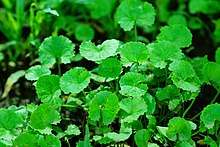Hydrocotyle sibthorpioides
| Lawn marshpennywort | |
|---|---|
 | |
| The lawn marshpennywort | |
| Scientific classification | |
| Kingdom: | Plantae |
| (unranked): | Angiosperms |
| (unranked): | Eudicots |
| (unranked): | Asterids |
| Order: | Apiales |
| Family: | Araliaceae |
| Genus: | Hydrocotyle |
| Species: | H. sibthorpioides |
| Binomial name | |
| Hydrocotyle sibthorpioides Lam. | |
| Synonyms[1] | |
| |
Hydrocotyle sibthorpioides is a small plant native to southeastern Asia. It is also referred to as lawn marshpennywort.[2] It is a dicot, traditionally placed in the family Apiaceae, but more recently suggested to belong in the Araliaceae.[3] It grows in great abundance when the conditions are right. Hydrocotyle sibthorpioides originated in southeastern Asia, but is slowly spreading in the United States, along with other places around the world. It can grow in a wide variety of habitats. This plant has been used for medicinal purposes in Asia.
Description
The leaf width ranges from 0.5 to 2 cm. The plant has a moderate growth rate[4] and produces small flowers. The flowers are a faint yellow with a hint of purple.[5] Flower clusters are simple and flat-topped or rounded. There are inconspicuous involucral bracts at the base of each flower and indistinct sepals. The leaves are simple, with small leafy outgrowth at the base, kidney-shaped to round. Leaf edges are scalloped. The leaves of H. sibthorpioides are broad and alternate. The peltate leaves are often described as egg shaped; all of the leaves are hairless and they often have five to seven shallow lobes around the edge. H. sibthorpioides has fruits that are flat and the break in half when the plant reaches maturity. Once the fruit has broken open there is one seed on each side.[6] The fruits are elliptical to round with thin ridges and no oil tubes (vitta), which is characteristic in the fruit of umbelliferous plants.[7]
Taxonomy
Hydrocotyle sibthorpioides is traditionally treated within the family Apiaceae,[8] although recent results place it in the Araliaceae.[3] A moleculary phylogeny shows H. sibthorpioides to be closely related to H. americana, H. bonariensis, H. bowlesioides, H. hirsute, and H. umbellata, among others.[8]
Distribution and habitat
Hydrocoytle sibthorpioides is most commonly found in southeastern Asia. Although is native to Asia, there are parts of the United States that this species thrives as an introduced species, particularly in the eastern US and some areas in California.[9] Recently, H. sibthorpioides has reported to flourish in Australia. It occurs from in southeast Australia from Brisbane and Sydney. However it is not found in Western Australia.[10] This plant is able to grow in a wide variety of habitats, from dry areas to locations occasionally submerged. It can also be found between sidewalk cracks, and it is increasingly occurring as a lawn weed.[11]
Culture
For the plant to reach its full growth it must have full sunlight.[9] It can tolerate temperatures between 10 and 30 degrees Celsius but grows best when the temperature stays between 20 and 28 degrees Celsius. It has a pH soil preference that ranges from 5 to 7. The propagation for this plant is mostly by cuttings.[12]
Conservation status
The conservation status for Hydrocotyle sibthorpioides is of least concern; it continues to grow and spread throughout the United States along with other regions of the world such as Australia.[13]
Medical uses
Hydrocotyle sibthorpioides is used to treat asthma in areas of Nepal. Bengali villagers use the entire plant to help heal bone fractures.[14] The plant extract has also been used to treat edema, fever, throat pain, psoriasis, and the hepatitis B virus.[15]
References
- ↑ The Plant List: A Working List of All Plant Species, retrieved 17 July 2017
- ↑ "Hydrocotyle sibthorpioides". Natural Resources Conservation Service PLANTS Database. USDA. Retrieved 8 December 2016.
- 1 2 Chandler, G. T.; Plunkett, G. M. (2004-02-01). "Evolution in Apiales: nuclear and chloroplast markers together in (almost) perfect harmony". Botanical Journal of the Linnean Society. 144 (2): 123–147. doi:10.1111/j.1095-8339.2003.00247.x. ISSN 0024-4074.
- ↑ Gross, Tom. "Hydrocotyle sibthorpioides". PlantFinder. aquaticplantcentral.com. Retrieved 7 November 2016.
- ↑ "Hydrocotyle sibthorpioides". Yarra Ranges. Retrieved 7 November 2016.
- ↑ "Pennywort (Hydrocotyle sp.)". UCIPM. Retrieved 7 November 2016.
- ↑ Flora of China. "Hydrocotyle Linn.". Family List. Retrieved 2008-04-25.
- 1 2 "Hydrocotyle sibthorpioides Lam". ITIS Report. ITIS. Retrieved 7 November 2016.
- 1 2 "Hydrocotyle sibthorpioides Lam. Lawn Marshpennywort". USDA plants. Retrieved 7 November 2016.
- ↑ "Hydrocotyle sibthorpioides Lam". Atlas of Living Australia. Retrieved 7 November 2016.
- ↑ Weakley, Alan. "Flora of the Southern and Mid Atlantic States". UNC Herbarium Weakley Flora. Retrieved 7 November 2016.
- ↑ "Hydrocotyle sibthorpioides". Flowgrow- Wir Lassen es Wachsen. Retrieved 7 November 2016.
- ↑ "Hydrocotyle sibthorpioides- Lam". Plants for a Future. Retrieved 7 November 2016.
- ↑ Rahmatullah, Mohammed (2010). "A Comparative Analysis of Medicinal Plants used by Folk Medicinal Healers in Villages Adjoining the Ghaghut, Bengali, Padma Rivers of Bangladesh". American- Eurasian Journal of Sustainable Agriculture (4): 70–85.
- ↑ Huang, Q., Zhang, S., Huang, R., Wei, L., Chen, Y., Lv, S., ... & Lin, X. (2013). Isolation and identification of an anti-hepatitis B virus compound from Hydrocotyle sibthorpioides Lam. Journal of Ethnopharmacology, 150(2), 568-575